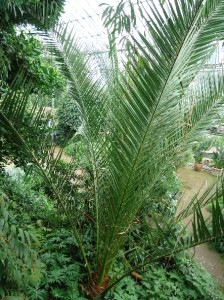Phoenix canariensis
This solitary palm can reach heights in excess of 40 metres in its native islands, where it is also known as the pineapple palm. It is a close relative of the true date palm (P. dactylifera) but produces a much thinner, less fleshy fruit that is not really worth eating. The pineapple epithet derives from the swollen stem, patterned by leaf scars, not unlike that fruit, especially in shorter specimens.
Its robust trunks and elegantly weeping leaves make it a popular promenade presence in many Mediterranean countries and indeed around the Canaries. Its most useful product is the sap which is processed into palm syrup, chiefly on La Gomera.
CLICK HERE TO GO TO NEXT PALMThis post is part of The World of Palms Glasshouse Trail

